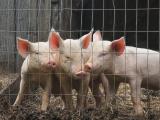Jul 13, 2009 (CIDRAP News) – The pandemic H1N1 virus in different animal models causes more lung damage and can replicate efficiently in the trachea and deep in the lungs when compared with its seasonal flu counterpart—a pattern seen in the 1918 pandemic virus—according to a study published today.
Though the new report appears to confirm the pathogenicity findings of two studies that appeared Jul 2 in Science, the more severe disease that researchers are seeing in animal experiments runs counter to the mild-to-moderate infection profile in humans.
In a multifaceted study that appears in an early online edition of Nature, the group, from Japan and the University of Wisconsin, conducted a host of other experiments—both in vitro and in vivo—to better characterize the risks of the new virus.
Yoshihiro Kawaoka, PhD, a researcher from the University of Wisconsin-Madison who led the Nature study, said in a press release that the study may help clear up misunderstandings people have about the new virus. "People think this pathogen may be similar to seasonal influenza," he said. "This study shows that is not the case. There is clear evidence the virus is different than seasonal influenza."
Animal models show pathogenicity trends
The research group evaluated pathogenicity in four animal models: mice, ferrets, macaques, and pigs. They used pandemic H1N1 viruses obtained this year from patients in California, Wisconsin, the Netherlands, and Japan, as well as a seasonal H1N1 virus from Japan.
They found that the pandemic H1N1 virus replicated more efficiently in the lungs and that it exhibits a different pro-inflammatory cytokine response pattern in infected animals. However, they wrote that more study is needed to understand the relevance of the cytokine findings.
In macaques, animals infected with the pandemic H1N1 virus had greater body temperature increases, but body weight loss wasn't different from animals that were infected with the seasonal flu virus. The new virus replicated efficiently in the lungs and other respiratory organs, similar to highly pathogenic influenza viruses.
Pathological examination revealed that the novel virus caused more severe lung lesions that contained type 2 pneumocytes—a finding that has been reported with H5N1 avian influenza viruses.
In the ferret model, the group found more severe bronchopneumonia in the animals infected with the pandemic H1N1 virus. Researchers also used ferrets to test transmission, a key factor in human-to-human spread of the virus. They placed ferrets infected with either the pandemic or seasonal flu virus in perforated cages next to, but not touching, cages housing uninfected ferrets.
They found that transmission patterns for the novel H1N1 virus were comparable to that of seasonal H1N1 and H3N2 strains. An avian H1N1 virus, however, did not transmit from the infected to the uninfected ferrets.
Kawaoka told CIDRAP News that the transmission study was designed to gauge droplet, not aerosol, transmission.
To test virus replication of the pandemic H1N1 virus in pathogen-free miniature pigs, they inoculated the animals with either the new virus or a classical swine H1N1 virus. Both viruses replicated efficiently in the respiratory organs of the pigs, though the ones infected with the pandemic strain were asymptomatic, despite having slightly more apparent bronchitis and bronchiolitis.
The group suggested that asymptomatic infection, despite efficient viral replication, may explain why no novel H1N1 outbreaks in pigs were detected before the virus surfaced in humans.
Antiviral and serology findings
Testing antiviral action against the viruses in mice, the researchers found that the pandemic H1N1 virus was susceptible to licensed neuraminidase inhibitors oseltamivir (Tamiflu) and zanamivir (Relenza), as well as an experimental one called R-125489. An experimental broad-spectrum RNA polymerase inhibitor, called compound T-705, was also effective against the pandemic H1N1 virus.
The antiviral compounds were also effective against the seasonal flu viruses, but oseltamivir resistance was seen against seasonal H1N1.
In a serology experiment that measured neutralizing activity of blood from a wide range of age-groups against both pandemic and seasonal H1N1, the investigators found no appreciable neutralizing bodies against the novel flu virus in people who were born after 1920.
They concluded that infection with the 1918 virus, or a closely related human H1N1 virus, neutralized the novel flu virus. However, they noted that infection with the antigenically divergent H1N1 strains that circulated in the 1920s to 1950s, as well as in 1977, did not.
Experts say animal models have limits
Vincent Racaniello, PhD, professor of microbiology at Columbia University and author of Virology Blog, told CIDRAP News that the two recent studies in Science both showed that the new H1N1 strain replicates more extensively than the seasonal strain in the lower respiratory tracts of ferrets. However, the replication pattern with the new virus was not associated with significantly higher morbidity.
He said the Kawaoka study in Nature had similar conclusions, but it's not clear what that means for humans.
"We have already had over a million—probably several million—human infections with the new strain, and all agree the symptoms are mild, similar to those of seasonal flu," Racaniello said. "So it's not clear to me why these results should suddenly make us all fear that the new virus is in fact more virulent than we think."
Perhaps the results underscore the point that animal models are just models and don't reveal much about human infections, he added.
Racaniello cautioned against thinking of serious infections in patients with no known underlying conditions as evidence of pandemic H1N1's pathogenic potential. Subtle defects that can impair immune response, especially early in infection, can lead to lethal disease in otherwise healthy people, he said.
"In other words, you don't have to have heart disease to have a bad outcome with influenza."
"I don't think the results of any of the three papers should be interpreted to mean that 2009 H1N1 is more virulent than we think it is," he said, pointing out that there are enough differences among the three studys' results to cast doubt on any virulence extrapolations in humans.
Adolfo Garcia-Sastre, PhD, a virologist at Mount Sinai School of Medicine in New York City, said the Kawaoka study is very comprehensive. "The results are consistent with a more pronounced tropism for the lower respiratory tract, which is of concern," he said.
"However, previous H1N1 immunity in humans may dampen some of the more severe disease seen in animal models, which are naive."
Itoh Y, Shinya K, Kiso M, et al. In vitro and in vivo characterization of new swine-origin H1N1 influenza viruses. Nature 2009 Jul 13 early online edition [Abstract]
See also:
Jul 13 University of Wisconsin press release
Jul 2 CIDRAP News story "Studies: Novel H1N1 affects deep lung tissue, transmits fairly well"


















